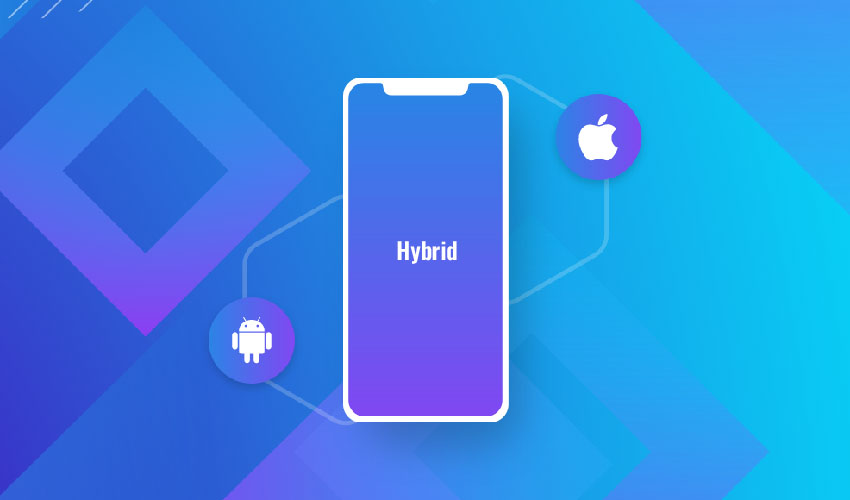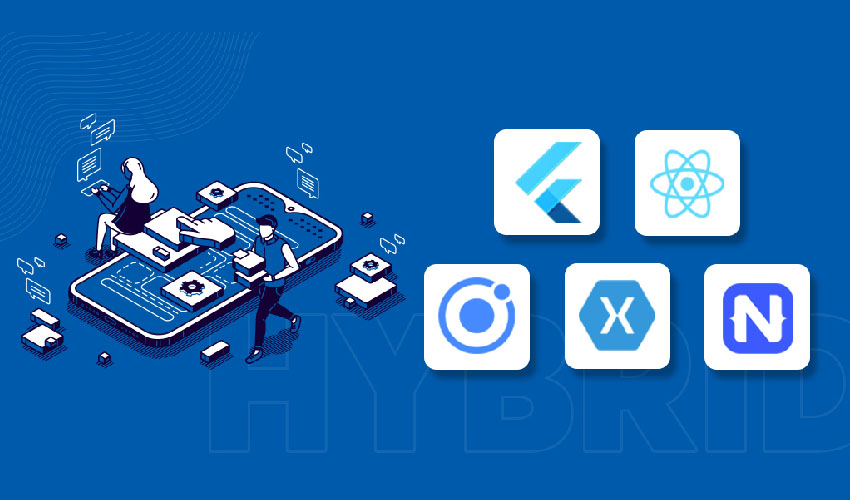Table of Contents
Understanding Hybrid App Development
In the contemporary realm of mobile applications, Hybrid App Development has emerged as a formidable solution, blending the strengths of both native and web applications. It embodies a unique approach that allows developers to leverage web technologies while harnessing the native capabilities of various platforms.
Defining Hybrid Apps
At its core, a hybrid app is an amalgamation of web and native applications. Leveraging technologies like HTML, CSS, and JavaScript, hybrid apps are developed using frameworks like React Native, Flutter, Ionic, and Xamarin, among others. They are then encapsulated within a native container, allowing them to function across multiple platforms.
Architectural Composition
Hybrid apps consist of two primary components: a backend built using web technologies and a native shell that acts as a wrapper around the web code. The native shell is essentially a thin layer that provides access to device-specific features such as camera, GPS, accelerometer, and more.
This architecture allows developers to write a single codebase, which, with minimal adjustments, can be deployed across various platforms. The framework handles the adaptation of the code to the specific operating systems, minimizing the need for platform-specific development.
Advantages of Hybrid App Development
- Cost-Effectiveness: Developing a single codebase significantly reduces development costs compared to building separate native apps for different platforms.
- Cross-Platform Compatibility: Hybrid apps offer seamless compatibility across various operating systems, maximizing market reach and reducing fragmentation issues.
- Faster Development Cycles: Reusing code components expedites development, enabling quicker iterations, updates, and feature implementations.
- Access to Device Features: Despite their web-based core, hybrid apps can leverage device capabilities, ensuring a rich user experience without sacrificing performance.
- Simplified Maintenance: With a single codebase, maintenance becomes streamlined, reducing the effort required for bug fixes, updates, and feature enhancements.
Challenges and Drawbacks
However, hybrid app development isn’t without its challenges:
- Performance Limitations: While advancements have narrowed the gap, hybrid apps might still lag behind native apps in handling resource-intensive tasks, complex animations, or graphics.
- Dependency on Third-Party Tools: Some hybrid frameworks rely on third-party plugins or tools, potentially introducing security vulnerabilities or compatibility issues.
- Native Functionality Constraints: Implementing highly specialized native features might be challenging within a hybrid environment, limiting the app’s capabilities.
- User Experience Variability: Achieving consistent user experience across platforms can be challenging due to differences in design standards and platform-specific behaviors.
- Offline Functionality: Hybrid apps may struggle to maintain full functionality offline compared to fully native apps, especially in areas with poor connectivity.
The Evolving Landscape and Future Prospects
Hybrid app development continues to evolve, driven by advancements in technology and the continuous refinement of hybrid frameworks. Frameworks like React Native, Flutter, and Ionic are relentlessly improving, addressing performance concerns and enhancing capabilities.
Moreover, the hybrid approach resonates with businesses seeking a balance between cost efficiency and broad market accessibility. The decision between hybrid and native development hinges on project specifics, audience demographics, and the app’s intended functionalities.
Advantages of Hybrid App Development
In the dynamic realm of application development, hybrid apps have emerged as a compelling solution, blending the best features of native and web applications. These versatile creations hold the potential to revolutionize the way businesses and developers approach app creation, offering a plethora of advantages that cater to diverse needs. Let’s delve into the intricacies of hybrid app development and explore its manifold advantages.
1. Cost-Effectiveness
Hybrid app development presents a significant advantage in terms of cost-effectiveness. The ability to write a single codebase that operates across multiple platforms, such as iOS, Android, and web browsers, reduces both development time and expenses. Unlike native apps that require separate coding for each platform, hybrid apps streamline the process, allowing developers to reuse components and thereby significantly lower the overall development costs.
2. Cross-Platform Compatibility
One of the standout advantages of hybrid app development lies in its seamless compatibility across various operating systems and devices. This cross-platform nature ensures broader accessibility, reaching a wider audience base without the need for separate versions tailored for different platforms. By leveraging a unified codebase, businesses can maximize their market reach, catering to users across diverse platforms and devices.
3. Faster Development Cycle
Hybrid apps facilitate a faster development cycle, primarily due to the reusability of code components. Developers can write code once and deploy it across multiple platforms, significantly reducing the time required for development. This agility in development not only accelerates the time-to-market for applications but also allows for quicker implementation of updates and new features, keeping the app relevant in an ever-evolving market.
4. Access to Device Features
Contrary to the limitations of traditional web apps, hybrid apps possess the capability to access device features. Through APIs and frameworks, hybrid apps can harness native device functionalities like camera, GPS, accelerometer, and more. This integration enhances the user experience by providing access to device-specific features without compromising on performance, thus offering a seamless blend of native and web capabilities.
5. Simplified Maintenance
Maintaining hybrid apps is notably simpler compared to managing multiple native apps developed for distinct platforms. With a single codebase, updates, bug fixes, and enhancements can be implemented uniformly across all platforms, streamlining the maintenance process. This simplicity not only reduces the workload for developers but also ensures a consistent user experience across different devices and operating systems.
6. Offline Functionality
Hybrid apps, equipped with certain frameworks and caching mechanisms, can offer improved offline functionality. By storing certain data locally, these apps can maintain some level of functionality even without an internet connection. While not as robust as native apps in this aspect, the offline capabilities of hybrid apps have significantly improved, allowing users to access certain features and content offline.
7. Enhanced Market Reach
The ability of hybrid apps to operate seamlessly across multiple platforms and devices translates into an expanded market reach for businesses. Instead of limiting their user base to a specific operating system or device, companies can cater to a wider audience, thereby increasing their potential customer base. This expanded market presence can result in higher user engagement and revenue opportunities.
8. Consistency in User Experience
Hybrid apps strive to offer a consistent user experience across different platforms and devices. While native apps may differ in terms of interface and user interaction due to platform-specific design guidelines, hybrid apps aim to maintain a uniform user experience. This consistency can contribute to better user satisfaction and ease of use, irrespective of the device or platform used to access the app.
9. Rapid Prototyping and Testing
The flexibility of hybrid app development allows for rapid prototyping and testing. Developers can create prototypes quickly by utilizing the same codebase for different platforms, enabling faster iterations and testing of various features. This agility in the development process enables businesses to adapt swiftly to user feedback and market demands, ensuring the delivery of a refined and user-centric final product.
10. Easier Implementation of Changes
The unified codebase of hybrid apps facilitates easier implementation of changes or modifications. Whether it’s fixing a bug, adding new features, or enhancing existing functionalities, developers can make alterations within the single codebase and deploy the changes across all platforms simultaneously. This simplification of the modification process contributes to the agility and responsiveness of hybrid app development.
Challenges in Hybrid App Development
Hybrid app development, with its fusion of native and web app elements, has emerged as a compelling solution for businesses aiming to reach a broad audience across multiple platforms while managing costs. However, this innovative approach is not without its challenges. Understanding and navigating these hurdles is crucial for developers and businesses seeking to harness the potential of hybrid apps effectively. In this exploration, we delve deep into the multifaceted challenges inherent in hybrid app development.
- Performance Optimization
One of the primary challenges in hybrid app development revolves around optimizing performance to match or exceed that of native applications. While hybrid apps have made significant strides, they may face limitations in handling intensive graphics, animations, or complex functionalities compared to their native counterparts. Balancing performance while utilizing web technologies within a native wrapper demands meticulous optimization and fine-tuning to deliver a seamless user experience across platforms.
- Framework Selection Dilemma
Choosing the right framework for hybrid app development is pivotal. With a plethora of frameworks available—such as React Native, Flutter, Ionic, and Xamarin—each with its strengths and limitations, the selection process becomes intricate. The challenge lies in identifying a framework that aligns with project requirements, offers robust performance, and supports future scalability, all while mitigating potential compatibility issues and technical debt.
- User Experience Consistency
Ensuring consistent user experience across various platforms remains a significant challenge in hybrid app development. Differences in design principles, device capabilities, and OS-specific functionalities pose hurdles in delivering a uniform and intuitive user interface. Achieving coherence in user experience demands meticulous attention to detail, adherence to platform-specific guidelines, and robust testing across multiple devices and operating systems.
- Native Functionality Integration
The seamless integration of native functionalities into hybrid apps presents another hurdle. While hybrid frameworks provide access to device features through plugins or APIs, implementing highly specialized or platform-specific native features might pose challenges. Ensuring smooth integration without compromising app performance or stability requires in-depth knowledge of native APIs and frameworks, often demanding additional development efforts.
- Security Concerns
Hybrid apps may introduce security vulnerabilities, primarily due to their reliance on web technologies and the integration of third-party plugins or tools. Addressing security concerns involves implementing robust encryption, adhering to best practices in secure coding, and vigilant monitoring of potential vulnerabilities introduced by third-party elements, all while ensuring data protection across platforms.
- Maintenance and Upgradation
Maintaining a hybrid app can be complex due to its single codebase across multiple platforms. While this simplicity streamlines initial development, it can lead to challenges in managing updates, bug fixes, and feature enhancements. Balancing the need for consistent updates across different platforms without disrupting user experience requires meticulous planning and version control strategies.
- Offline Functionality and Performance
Hybrid apps might face challenges in delivering seamless offline functionality compared to native apps. Balancing offline capabilities with app performance and ensuring smooth transitions between online and offline modes is a persistent challenge. Efficient data caching, smart synchronization strategies, and optimizing app performance in offline scenarios remain crucial yet intricate tasks.
Popular Hybrid App Frameworks
The demand for hybrid app development has surged in recent years, prompting the emergence and evolution of several robust frameworks. These frameworks serve as the backbone for creating cross-platform applications, offering developers a blend of flexibility, efficiency, and performance. Let’s dive into some of the most prominent hybrid app frameworks reshaping the app development landscape.
1. React Native
React Native, developed by Facebook, has garnered immense popularity for its capability to build native-like applications using JavaScript and React. It allows developers to create apps for multiple platforms, including iOS and Android, using a single codebase. React Native’s “learn once, write anywhere” approach accelerates development and facilitates seamless performance.
Key Features:
- Hot Reloading: Enables developers to instantly view changes made in the code, enhancing the development workflow.
- Native Module Access: Allows integration of native code, ensuring access to device features and functionalities.
- Large Community Support: The extensive community offers resources, libraries, and solutions for troubleshooting.
2. Flutter
Flutter, developed by Google, stands out for its high-performance and visually appealing applications. It employs Dart as its programming language and offers a unique approach with its own set of widgets, eliminating the need for platform-specific UI components. Flutter’s “write once, run anywhere” philosophy ensures consistent user experience across platforms.
Key Features:
- Fast Development: Hot Reload feature speeds up the development process by instantly reflecting code changes.
- Customizable Widgets: Flutter’s rich set of widgets allows developers to craft highly customized UI designs.
- High Performance: Compiled to native ARM code, Flutter delivers near-native performance, resulting in smooth animations and interactions.
3. Ionic
Ionic has established itself as a preferred choice for building cross-platform applications using web technologies like HTML, CSS, and JavaScript. It leverages popular frontend frameworks like Angular and Vue.js to create performant and visually appealing apps. Ionic offers a library of pre-designed components and a suite of tools for development and deployment.
Key Features:
- UI Components: Ionic provides a vast array of pre-built UI components, ensuring consistent designs across platforms.
- Easy Deployment: With Cordova integration, Ionic simplifies the deployment process to various platforms.
- Community Plugins: Access to a wide range of community-developed plugins extends the functionality of Ionic apps.
4. Xamarin
Xamarin, acquired by Microsoft, empowers developers to build native-like apps using C# and .NET framework. It allows code sharing across platforms, enabling developers to achieve near-native performance. Xamarin.Forms simplifies the UI development process by offering a single, shared UI codebase.
Key Features:
- Code Reusability: Xamarin allows sharing up to 90% of code across different platforms, reducing development time and effort.
- Native API Access: Developers can access native APIs and functionalities directly from Xamarin, ensuring comprehensive app capabilities.
- Microsoft Integration: Seamless integration with Microsoft products and services facilitates robust app development.
5. PhoneGap / Apache Cordova
Apache Cordova, formerly known as PhoneGap, is an open-source framework that facilitates the development of hybrid mobile applications using web technologies. Cordova acts as a bridge, enabling access to device features through JavaScript APIs, making it easier to build apps for multiple platforms.
Key Features:
- Plugin Ecosystem: Cordova offers a vast plugin ecosystem, allowing developers to access native device functionalities.
- Simplified Development: Using familiar web technologies, developers can swiftly create cross-platform applications.
- Community Support: An active community continuously contributes to the framework, providing support and plugins.
6. NativeScript
NativeScript enables developers to build native mobile applications using JavaScript, TypeScript, or Angular. It provides direct access to native APIs, resulting in high-performance applications with a native look and feel. With NativeScript, developers can create apps for iOS and Android from a single codebase.
Key Features:
- Direct Access to Native APIs: Developers can leverage native APIs without any plugin or wrapper, ensuring optimal performance.
- Support for Angular and Vue.js: NativeScript allows integration with popular frontend frameworks, facilitating a robust development environment.
- Flexible UI Development: Offers flexibility in UI design, allowing developers to create customized interfaces easily.
Best Practices for Hybrid App Development
Hybrid app development has emerged as a compelling choice for businesses aiming to create versatile applications across multiple platforms while minimizing development time and costs. To harness the true potential of hybrid app development, adhering to best practices becomes pivotal. Let’s delve into a comprehensive guide outlining the essential best practices for crafting efficient, robust, and user-friendly hybrid applications.
1. Selecting the Right Framework
Choosing the appropriate framework lays the foundation for successful hybrid app development. Consider factors such as community support, performance, available plugins, and the ability to meet project requirements. Popular frameworks like React Native, Flutter, and Ionic offer diverse advantages, so evaluate them based on your project’s needs.
2. Optimal UI/UX Design
Prioritize an intuitive and seamless user interface (UI) and user experience (UX). Ensure consistency across platforms while adhering to platform-specific design guidelines. Elements like responsive design, intuitive navigation, and optimized layout contribute significantly to user satisfaction.
3. Performance Optimization
Efficient performance is crucial for user retention. Minimize unnecessary rendering and optimize code for faster load times. Leverage techniques like lazy loading, code splitting, and image optimization to enhance app performance across devices and platforms.
4. Native-Like Functionality
Integrate native device features judiciously to provide a native-like experience. Access device functionalities such as GPS, camera, accelerometer, and push notifications through plugins or APIs, ensuring seamless integration without compromising performance.
5. Code Reusability and Maintainability
Strive for maximum code reusability to expedite development and maintenance. Employ modular architecture, separating UI components from business logic, and utilize frameworks that facilitate code sharing across platforms.
6. Testing Strategy
Implement a robust testing strategy encompassing both manual and automated testing. Perform rigorous testing across various devices, browsers, and platforms to ensure compatibility, functionality, and performance. Tools like Appium, Jest, and Detox aid in automating testing processes.
7. Security Measures
Prioritize app security by employing best practices such as data encryption, secure authentication mechanisms, and regular security audits. Be cautious while integrating third-party plugins or APIs to mitigate potential security vulnerabilities.
8. Offline Functionality
Enhance user experience by providing seamless offline functionality. Implement caching mechanisms, local storage, and data synchronization to ensure the app remains functional even without an internet connection.
9. Continuous Integration and Deployment (CI/CD)
Adopt CI/CD pipelines to automate build, test, and deployment processes. This ensures quick iterations, faster updates, and seamless integration of new features while maintaining app stability.
10. Monitoring and Analytics
Implement robust analytics tools to gather insights into user behavior, app performance, and potential issues. Monitor app performance, crashes, and user interactions to identify areas for improvement and refine the app’s performance continually.
Future Trends in Hybrid App Development
In the dynamic realm of app development, hybrid apps have emerged as a compelling solution, amalgamating the best of native and web applications. As technology advances at an unprecedented pace, the future of hybrid app development holds promising trends that are set to redefine the landscape. Exploring these trends offers a glimpse into the potential evolution of hybrid apps and their impact on the tech industry.
Progressive Web Apps (PWAs) Integration
Progressive Web Apps (PWAs) are gaining traction for their ability to combine the best features of web and mobile applications. These apps leverage modern web capabilities to deliver an app-like experience across various devices and platforms. Future trends in hybrid app development are likely to see a closer integration of PWAs, enhancing the performance, user experience, and offline functionality of hybrid apps.
Enhanced Cross-Platform Development Frameworks
The evolution of cross-platform development frameworks like React Native, Flutter, Xamarin, and Ionic continues to drive innovation in hybrid app development. Future iterations of these frameworks are anticipated to offer more robust tools, improved performance, and streamlined development processes. Additionally, these frameworks might focus on facilitating seamless integration with emerging technologies such as AI, AR/VR, and IoT.
AI and Machine Learning Integration
The integration of AI and machine learning capabilities within hybrid apps is poised to be a transformative trend. These technologies can empower apps to deliver personalized experiences, predictive analytics, and enhanced decision-making functionalities. Future hybrid apps might harness AI algorithms to optimize user interactions, automate tasks, and offer tailored content based on user behavior and preferences.
Augmented Reality (AR) and Virtual Reality (VR) Integration
The convergence of hybrid app development with AR and VR technologies presents an exciting frontier. The future of hybrid apps could involve the seamless integration of AR/VR experiences, enabling immersive interactions and innovative applications across industries like gaming, education, healthcare, and retail. Frameworks supporting AR/VR development for hybrid apps are expected to evolve, enabling developers to create captivating experiences.
Security and Privacy Enhancements
As data privacy concerns continue to escalate, the future of hybrid app development will prioritize robust security measures. Frameworks and development tools will likely focus on bolstering app security, implementing encryption, and adhering to strict privacy standards. Additionally, advancements in authentication methods and secure data transmission protocols will be crucial to maintain user trust and safeguard sensitive information.
Emphasis on Performance Optimization
Addressing performance limitations has been a recurring challenge in hybrid app development. Future trends will revolve around enhancing app performance by optimizing code, leveraging hardware capabilities, and refining rendering processes. Frameworks and tools will evolve to minimize load times, reduce app size, and ensure smooth functionality across various devices and operating systems.
Voice-enabled interfaces and Natural Language Processing
The integration of voice-enabled interfaces and natural language processing (NLP) into hybrid apps is poised to revolutionize user interactions. Future hybrid apps might incorporate voice commands, speech recognition, and NLP capabilities, enabling users to interact with apps more intuitively and efficiently. This trend aligns with the growing popularity of virtual assistants and smart speakers, paving the way for seamless voice-driven app experiences.
Internet of Things (IoT) Integration
The proliferation of IoT devices presents an opportunity for hybrid apps to expand their capabilities. Future trends in hybrid app development might involve closer integration with IoT ecosystems, allowing apps to interact with a multitude of connected devices. This integration could enable functionalities like remote device control, data monitoring, and seamless IoT device management within hybrid applications.




















